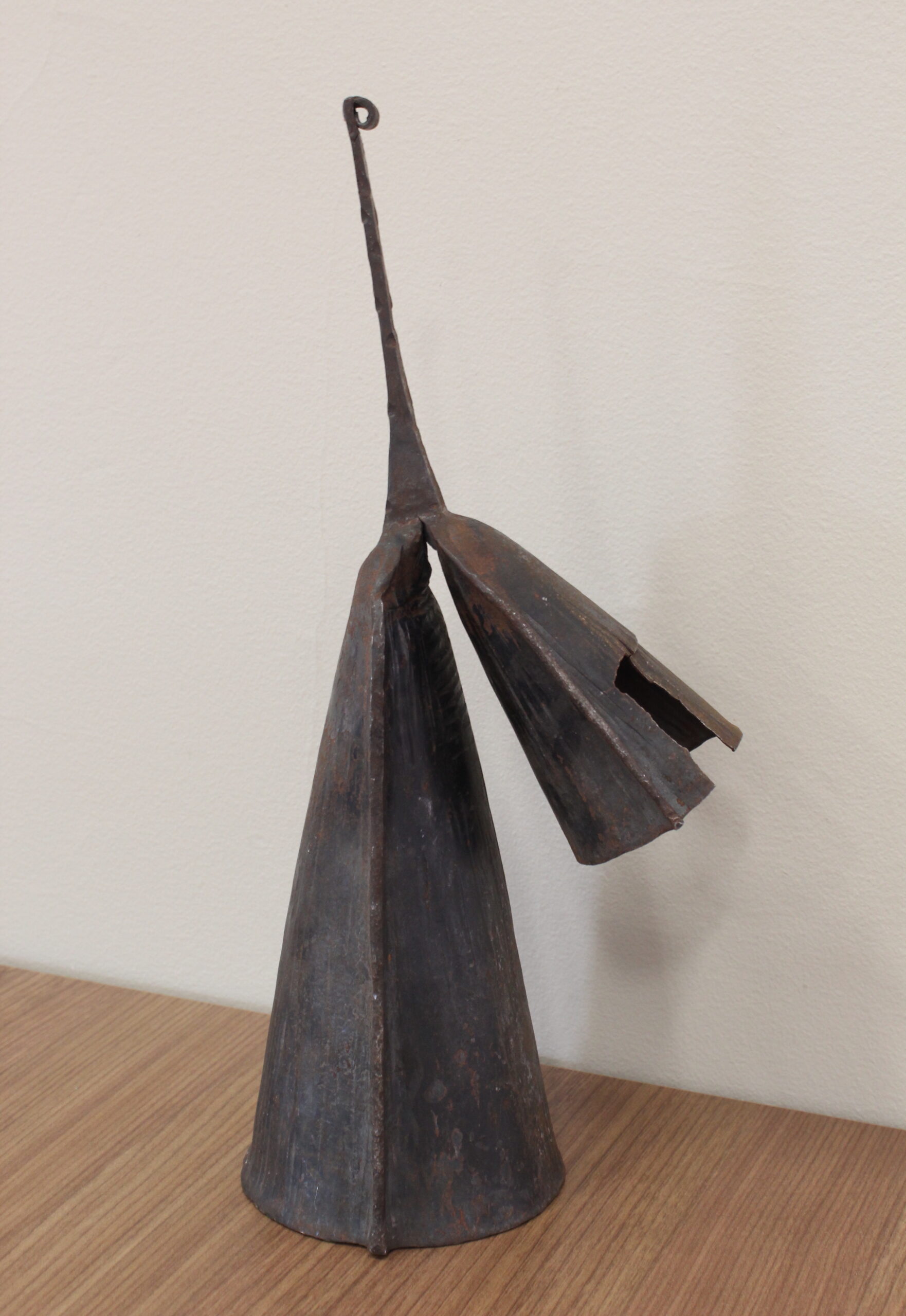About the instrument
The gankogui is a metal percussion instrument from the Ewe people in Ghana. It is made of two metal bells – one large and one small – fused together at the neck where a long thin handle is attached. Like many other metal tools in Ghanaian society, it is crafted by a blacksmith, who sources the material from scrap metal from cars, broken farm tools such as hoes and machetes, and even from other broken gankoguis. The bell is played by hitting it with a wooden or metal stick.
The gankogui’s steady rhythm drives the beat and tempo for the entire ensemble. According to Professor John Dankwa, director of Wesleyan’s West African Drumming ensembles, the gankogui is considered the group’s “life support” and the most important instrument: “It supplies the timeline against which all the other instruments play. … Without it, the entire rhythm and framework of the music is impoverished.”

Becoming broken: how and why?
Similar to the janggo, suling, and bachi, the gankogui is susceptible to changes in environmental conditions that can weaken the material. Professor Dankwa explains that extreme temperature can stress the instruments: “When the room is too hot, it affects the instruments… Just as we cannot withstand very hostile weather situations, … the instruments cannot withstand that as well.” The metal can tolerate low humidity, but a humidifier frequently runs in the rehearsal space to protect the drums, which are more sensitive to dryness. In Ghana, the high humidity can be an issue for the health of the instruments. Professor Dankwa relates his experience at the University of Cape Coast in southern Ghana: “Much of the gankoguis we had at the music department rusted, because the department is very close to the seashore, and the salty nature of the shore and then the breeze that comes from the sea affects these instruments, to the extent that even the pianos get detuned at some point.”
Even considering the weathering effects of climate, Professor Dankwa cites instrument use and misuse as the number one reason for damage to the gankoguis: “There are techniques used for playing these instruments, and the moment you miss that technique it’s like the instruments suffers, you end up injuring it.” Taking care in how the instruments are stored, too, can play a role in the gankogui’s lifespan. Professor Dankwa prefers to store the gankoguis in a cabinet rather than jumbled loose in a box. Nevertheless, over years of teaching he has inevitably accumulated a collection of gankoguis that have cracked, split, or come loose at the joint between the two bells.

Repair or retire?
In Ghana, a broken gankogui is returned to the blacksmith as scrap metal that then gets crafted into farm implements such as hoes or machetes, or even re-crafted into new gankoguis. According to Professor Dankwa, this lifecycle of the metal material – from instrument to farm tool and back to instrument again – relates to “the religious idea of reincarnation, being born in a certain form, dying, and then coming back in another form.”
At Wesleyan, there is no local blacksmith to reincarnate the gankoguis, and so many are simply thrown away or recycled for scrap metal if they are deemed unsafe for playing. The cracked metal can be sharp or can break off in pieces, making them potential dangerous. However, if the crack is small and the instrument still plays in tune, then it can still be used for performance.
A broken instrument is more than a cracked piece of animal skin, wood, bamboo, or metal; there is a sense of lost animacy, the loss of a life, and perhaps a glimpse of our own mortality. As Professor Dankwa reflects, “When I see a broken instrument, metaphorically, I see the end of myself in there. Because if you do not take care of these instruments, just as if I don’t take very good care of myself, I may one day be broken into pieces, meaning heading towards the grave. So are these instruments, and so I see that, well, they are musical instruments, but in some in some respects, they reflect much of our nature.”
—-
In the fall 2020 semester, I collaborated with Professor John Dankwa to write a piece featuring the broken gankoguis for final project for Professor Paula Matthusen’s Center for the Humanities seminar, “(Un)Sound Projections.” Using the structure of the instrument’s lifecycle, the piece transitions between rhythms, composed by Professor Dankwa, that represent the car scraps, the farm tools, and the gankoguis themselves. You can watch the performance here: https://youtu.be/_0mxfkwu1QA?t=2119.
Click here for a demonstration of the gankogui, from Wesleyan’s Virtual Instrument Museum.
Click here for a video of the West African Drumming and Dance concert, May 2021.
Sources
MacGaffey, Wyatt. “The Blacksmiths of Tamale: The Dynamics of Space and Time in a Ghanaian Industry.” Africa: Journal of the International African Institute 79, no. 2 (2009): 169-185.
Interview with John Dankwa
While Wesleyan’s campus is closed to the general public due to Covid restrictions, we welcome all visitors to explore this virtual exhibit. Please click on the links below to see other posts:


